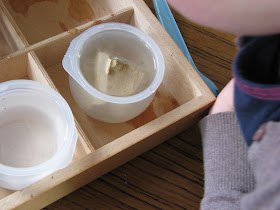This was the third in the series of earth science sessions that I have put together for one of the HE groups that we go to. The first was to do with fossils and last month we looked at plate tectonics and the structure of the earth. This month we looked at rocks and minerals. I passed around a piece of granite to look at and told the children that it was a rock and got them to describe what they saw. They identified different coloured flecks in the rock, some shiny, some dull - I explained that these were minerals and that minerals were the ingredients of rocks. I told them that granite was an igneous rock, which means 'made by fire' and how igneous rocks looked different - we compared granite and pumice and talked about how the granite had cooled slowly as it was pushed to the surface, allowing the different minerals time to clump together, and that the pumice had cooled rapidly after being blown from a volcano as molten lava and so the minerals had stayed mixed together, giving the even tone.
We went to the table and I used wax crayons to explain and demonstrate the different types of rocks. There are many permutations of this idea around on the web and as I haven't used one specific plan so I haven't credited it to anyone in particular. The demonstration requires a heavy based pot with a depth of just boiled water in it and it went like this:
- Sedimentary Rocks are rocks made from layers of rock particles, dust, sand and mud that filters down through oceans and lakes to the bottom, and becomes pressed into layers. The children were familiar with this concept from the fossils session. I had a bag of grated wax crayons as the particles and pressed them into a small foil cake tin to show how they form into sedimentary rock.
- Igneous rocks - these are made when minerals are melted due to the incredible temperatures under the earth's surface - I broke crayons up and put them into another foil container and floated it on the water and left it until the crayons had completely melted (see picture above where they are partially melted).
- Metamorphic rocks - these can be made from sedimentary or igneous rocks or a mixture of both, where they are changed by the immense heat and pressure and the length of time they are exposed to these forces under the earth's surface. To do this I put some of the sedimentary rock I made, some pieces of an igneous rock I had made earlier and some crayon pieces and floated them in a foil tin on the surface. After they had partially melted, i took the tin out and pressed them down with a spoon to represent the pressure they would be under - the children could see that the crayon pieces had changed from what they were.
We then went on to investigate how minerals are told apart by minerologists - by their different properties. I set up 'investigation stations' with a poster of printed instructions (these were intended that they be done by the children with their parent to help read and guide them.
Station 1 was Moh's scale of hardness, or the scratch test.......
Station 2 was the streak test, looking at what colours were left behind by the minerals when dragged across a porous surface (AKA the back of a wall tile begged from the local tile place!).
The pyrites surprised faith as it glittered like gold but left a greeny black streak!
Station 3 was the magnetic test - only rocks with heamatite in will show attraction to the magnet - I guess they found one!Station 4 was an acid bath to test for the presence of calcite in various rocks - I have to apologise to the resources library for the strong smell of vinegar present in some of the returning samples!!
The session didn't work so well today as it has previously. There were more families there and therefore a lot more background noise from the children that chose not to participate which caused me to have to almost shout over it at times and distracted some of the children from concentrating on the session. I chatted about it with the group organisers and we have a couple of ideas to try next time to make it work even with a larger number of families attending the group. There are some fabulous 'foodie' demonstrations to use to illustrate how the different rocks are made - I wasn't able to use them this time due to allergies in the children coming to the group, but am saving them up for when it comes up again with my children!!
There is much more detail and a scripted plan, as well the instruction posters for the mineral investigation stations, available as googledocs to download, print and use here:







No comments:
Post a Comment